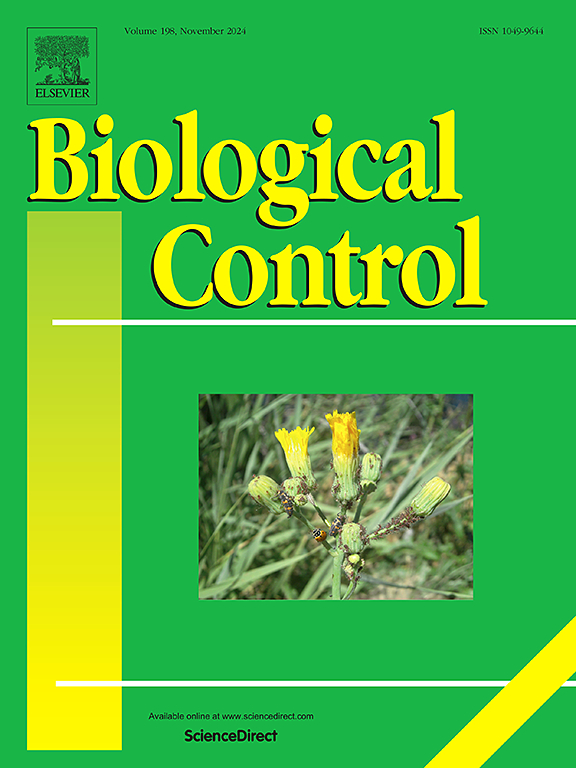持久性和商业性线虫菌株在防治山核桃象鼻虫和其他象鼻虫方面的比较
IF 3.7
2区 农林科学
Q2 BIOTECHNOLOGY & APPLIED MICROBIOLOGY
引用次数: 0
摘要
山核桃象鼻虫是山核桃的主要害虫。此外,福乐玫瑰甲虫(FRB)和双带状日本象鼻虫(TJW)等象鼻虫以山核桃的叶和根为食。昆虫病原线虫(EPNs)已被证明是管理山核桃象鼻虫的有效工具。然而,epn需要经常重新应用。因此,有必要开发持久性epn菌株,以减少使用频率和降低使用率。在本研究中,我们在实验室和田间比较了两种EPN持久菌株NY01 ‘ (Steinernema carpocapsae Weiser)和NY04 ’ (Steinernema feltiae Filipjev)与两种商品EPN菌株ScAll (S. carpocapsae)和SfSn (S. feltiae)。在野外研究中,比较了每对epn对山核桃象鼻虫、FRB和TJW的抑制能力,并进行了纯水对照。epn仅在研究的第一年(2022年)应用,并在2022年和2023年监测昆虫种群。在格鲁吉亚的实地研究中,在两个研究年份中,任一种线虫类型处理的树木捕获的TJW明显减少。在俄克拉何马州的实地研究中,在两个研究年份,与持久性线虫和对照相比,在使用商业线虫处理的树木上捕获的山核桃象牙虫明显减少。在实验室试验中,这四种菌株的存活率缺乏一致性。本研究的结果表明,商业线虫可以在两个田间季节中大量携带,并且可以以显着较低的施用率施用,并且仍然提供害虫抑制。本文章由计算机程序翻译,如有差异,请以英文原文为准。
Evaluation of persistent versus commercial nematode strains for management of Curculio caryae (Horn) and other weevils in pecan
Pecan weevil is a key pest of pecans. In addition, weevils such as Fuller rose beetle (FRB) and two-banded Japanese weevil (TJW) feed on pecan foliage and roots. Entomopathogenic nematodes (EPNs) have previously been shown to be effective tools for pecan weevil management. However, EPNs need frequent reapplication. Thus, there is a need to develop persistent strains of EPNs that can be applied less frequently and at lower rates. In this study, we compared two persistent strains of EPNs, NY01′ (Steinernema carpocapsae Weiser) and NY04′ (Steinernema feltiae Filipjev), against two commercial EPN strains, ScAll (S. carpocapsae) and SfSn (S. feltiae), in the lab and field. For the field study, the suppressive ability of each pair of EPNs on pecan weevil, FRB, and TJW was compared alongside a water only control. EPNs were only applied in the first year of the study (2022) and insect populations were monitored in 2022 and 2023. For the field study in Georgia, significantly fewer TJW were caught in trees treated with either nematode type in both study years. For the field study in Oklahoma, significantly fewer pecan weevils were caught in trees treated with commercial nematodes compared to the persistent nematodes and control in both study years. In lab trials, there was a lack of consistency in survival of the four strains. The results of this study indicate that commercial nematodes can have substantial carryover across two field seasons and can be applied at a significantly lower rate and still provide pest suppression.
求助全文
通过发布文献求助,成功后即可免费获取论文全文。
去求助
来源期刊

Biological Control
生物-昆虫学
CiteScore
7.40
自引率
7.10%
发文量
220
审稿时长
63 days
期刊介绍:
Biological control is an environmentally sound and effective means of reducing or mitigating pests and pest effects through the use of natural enemies. The aim of Biological Control is to promote this science and technology through publication of original research articles and reviews of research and theory. The journal devotes a section to reports on biotechnologies dealing with the elucidation and use of genes or gene products for the enhancement of biological control agents.
The journal encompasses biological control of viral, microbial, nematode, insect, mite, weed, and vertebrate pests in agriculture, aquatic, forest, natural resource, stored product, and urban environments. Biological control of arthropod pests of human and domestic animals is also included. Ecological, molecular, and biotechnological approaches to the understanding of biological control are welcome.
 求助内容:
求助内容: 应助结果提醒方式:
应助结果提醒方式:


